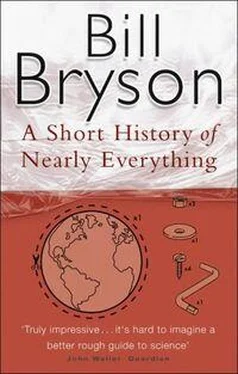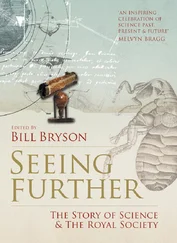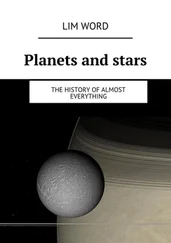Under Drake’s equation you divide the number of stars in a selected portion of the universe by the number of stars that are likely to have planetary systems; divide that by the number of planetary systems that could theoretically support life; divide that by the number on which life, having arisen, advances to a state of intelligence; and so on. At each such division, the number shrinks colossally-yet even with the most conservative inputs the number of advanced civilizations just in the Milky Way always works out to be somewhere in the millions.
What an interesting and exciting thought. We may be only one of millions of advanced civilizations. Unfortunately, space being spacious, the average distance between any two of these civilizations is reckoned to be at least two hundred light-years, which is a great deal more than merely saying it makes it sound. It means for a start that even if these beings know we are here and are somehow able to see us in their telescopes, they’re watching light that left Earth two hundred years ago. So they’re not seeing you and me. They’re watching the French Revolution and Thomas Jefferson and people in silk stockings and powdered wigs-people who don’t know what an atom is, or a gene, and who make their electricity by rubbing a rod of amber with a piece of fur and think that’s quite a trick. Any message we receive from them is likely to begin “Dear Sire,” and congratulate us on the handsomeness of our horses and our mastery of whale oil. Two hundred light-years is a distance so far beyond us as to be, well, just beyond us.
So even if we are not really alone, in all practical terms we are. Carl Sagan calculated the number of probable planets in the universe at large at 10 billion trillion-a number vastly beyond imagining. But what is equally beyond imagining is the amount of space through which they are lightly scattered. “If we were randomly inserted into the universe,” Sagan wrote, “the chances that you would be on or near a planet would be less than one in a billion trillion trillion.” (That’s 10 33, or a one followed by thirty-three zeroes.) “Worlds are precious.”
Which is why perhaps it is good news that in February 1999 the International Astronomical Union ruled officially that Pluto is a planet. The universe is a big and lonely place. We can do with all the neighbors we can get.
3 THE REVEREND EVANS’S UNIVERSE
WHEN THE SKIES are clear and the Moon is not too bright, the Reverend Robert Evans, a quiet and cheerful man, lugs a bulky telescope onto the back deck of his home in the Blue Mountains of Australia, about fifty miles west of Sydney, and does an extraordinary thing. He looks deep into the past and finds dying stars.
Looking into the past is of course the easy part. Glance at the night sky and what you see is history and lots of it-the stars not as they are now but as they were when their light left them. For all we know, the North Star, our faithful companion, might actually have burned out last January or in 1854 or at any time since the early fourteenth century and news of it just hasn’t reached us yet. The best we can say-can ever say-is that it was still burning on this date 680 years ago. Stars die all the time. What Bob Evans does better than anyone else who has ever tried is spot these moments of celestial farewell.
By day, Evans is a kindly and now semiretired minister in the Uniting Church in Australia, who does a bit of freelance work and researches the history of nineteenth-century religious movements. But by night he is, in his unassuming way, a titan of the skies. He hunts supernovae.
Supernovae occur when a giant star, one much bigger than our own Sun, collapses and then spectacularly explodes, releasing in an instant the energy of a hundred billion suns, burning for a time brighter than all the stars in its galaxy. “It’s like a trillion hydrogen bombs going off at once,” says Evans. If a supernova explosion happened within five hundred light-years of us, we would be goners, according to Evans-“it would wreck the show,” as he cheerfully puts it. But the universe is vast, and supernovae are normally much too far away to harm us. In fact, most are so unimaginably distant that their light reaches us as no more than the faintest twinkle. For the month or so that they are visible, all that distinguishes them from the other stars in the sky is that they occupy a point of space that wasn’t filled before. It is these anomalous, very occasional pricks in the crowded dome of the night sky that the Reverend Evans finds.
To understand what a feat this is, imagine a standard dining room table covered in a black tablecloth and someone throwing a handful of salt across it. The scattered grains can be thought of as a galaxy. Now imagine fifteen hundred more tables like the first one-enough to fill a Wal-Mart parking lot, say, or to make a single line two miles long-each with a random array of salt across it. Now add one grain of salt to any table and let Bob Evans walk among them. At a glance he will spot it. That grain of salt is the supernova.
Evans’s is a talent so exceptional that Oliver Sacks, in An Anthropologist on Mars , devotes a passage to him in a chapter on autistic savants-quickly adding that “there is no suggestion that he is autistic.” Evans, who has not met Sacks, laughs at the suggestion that he might be either autistic or a savant, but he is powerless to explain quite where his talent comes from.
“I just seem to have a knack for memorizing star fields,” he told me, with a frankly apologetic look, when I visited him and his wife, Elaine, in their picture-book bungalow on a tranquil edge of the village of Hazelbrook, out where Sydney finally ends and the boundless Australian bush begins. “I’m not particularly good at other things,” he added. “I don’t remember names well.”
“Or where he’s put things,” called Elaine from the kitchen.
He nodded frankly again and grinned, then asked me if I’d like to see his telescope. I had imagined that Evans would have a proper observatory in his backyard-a scaled-down version of a Mount Wilson or Palomar, with a sliding domed roof and a mechanized chair that would be a pleasure to maneuver. In fact, he led me not outside but to a crowded storeroom off the kitchen where he keeps his books and papers and where his telescope-a white cylinder that is about the size and shape of a household hot-water tank-rests in a homemade, swiveling plywood mount. When he wishes to observe, he carries them in two trips to a small deck off the kitchen. Between the overhang of the roof and the feathery tops of eucalyptus trees growing up from the slope below, he has only a letter-box view of the sky, but he says it is more than good enough for his purposes. And there, when the skies are clear and the Moon not too bright, he finds his supernovae.
The term supernova was coined in the 1930s by a memorably odd astrophysicist named Fritz Zwicky. Born in Bulgaria and raised in Switzerland, Zwicky came to the California Institute of Technology in the 1920s and there at once distinguished himself by his abrasive personality and erratic talents. He didn’t seem to be outstandingly bright, and many of his colleagues considered him little more than “an irritating buffoon.” A fitness buff, he would often drop to the floor of the Caltech dining hall or other public areas and do one-armed pushups to demonstrate his virility to anyone who seemed inclined to doubt it. He was notoriously aggressive, his manner eventually becoming so intimidating that his closest collaborator, a gentle man named Walter Baade, refused to be left alone with him. Among other things, Zwicky accused Baade, who was German, of being a Nazi, which he was not. On at least one occasion Zwicky threatened to kill Baade, who worked up the hill at the Mount Wilson Observatory, if he saw him on the Caltech campus.
Читать дальше












